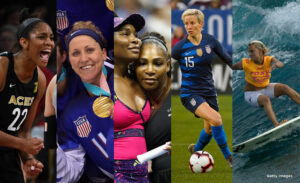
Baron Pierre de Coubertin, the founder of the Olympic Games, once said, “No matter how toughened a sportswoman may be, her organism is not cut out to sustain certain shocks.”
This thinking still exists in the controversial debate around gender and equal pay in sports.
While pay for women has improved over the years, the gap is still unacceptable.
According to Forbes, Women National Basketball Association players make an average of $71,635 a year, while the average National Basketball Association salary is $6.4 million.
There are people out there who would blame the gender pay gap in sports on women. We all hear comments like “women aren’t as entertaining,” “women aren’t as fast” and “women don’t dunk,” but the women’s game is not to blame.
In many sports, the gender pay gap is the result of sexist beliefs and decades of underfunding.
Amanda Batty, a former professional biker and an advocate for female athletes, says that your gender shouldn’t have to be the biggest obstacle in achieving your dream.
“Growing up, I was told I wasn’t good enough because I was a girl,” Batty said. “It didn’t matter that some of the boys had never touched a bike before. It was about gender not talent. Being a woman in sports has left me with more questions than answers.”
Women have been fighting for equality in many spheres throughout history, longing for rights equal to their male counterparts. Women were once not even permitted to participate in the Olympic Games. When women were finally allowed to participate in sports, many had to go through gender testing to assure they were not men trying to cheat their way around.
Unequal pay for female athletes is a violation of the rights they have worked so hard to attain.
Not only is creating a fair future for women’s sports important, but recognizing inequalities that currently exist, and understanding how they came to be, is essential for women entering and staying in the sports industry.
The Women’s Sports Foundation says that by the age of 14, girls drop out of sports at two times the rate of boys. Another survey shows that 51 percent of women quit playing sports by the age of 17.
It’s possible many women do not see sports as a space for them. Even if women do stay in their sports, they generally don’t think they are worthy of professional level play since they aren’t likely to see themselves on television; only four percent of all sports media coverage is devoted to women’s sports.
It’s also difficult for female athletes to continue in the world of sports when funding is very limited, which could be another reason for the lack of representation.
A Canadian Press report revealed that not only is funding the largest barrier for women participating in sports, but that men get a majority of athletic scholarships from universities.
Head coach for the “The Mikes” Women Football League at Boldmere St. Michaels, Simon Noakes, says that he values and respects women in sports.
“The representation of women in sports is disheartening. Women work just as hard as men and even more. Endorsing that women in sports aren’t deserving of appreciation and respect is ultimately downplaying their accomplishments,” Noakes said.
Women in sports have contributed tremendously and while many athletes would not participate under these circumstances, most female athletes still do because they have a sincere love for the sport.
Highlighting role models that they can follow helps if we want women to stay in sports. The Canada versus United States female hockey games are one of the biggest rivalries in sport. More than a billion people watched the Federation Internationale Football Association Women’s World Cup in 2019.
Victoria Morris, a licensed athletic trainer, says that there needs to be a changing attitude toward women in sports.
“Women have a place in sports,” Morrisa said. “Women’s sports can be just as important and engaging as men’s if given the opportunity. For women to feel supported and taken seriously, sporting organizations have to take decisive actions.”
If society is to continue seeing women in the sports realm — and truly believe that women are equal — the sporting industry must level the playing field.
There is no easy fix, but recognizing the barriers women in sports face, looking for sustainable solutions and highlighting role models that young female athletes can look up to, are the first steps in making a difference.